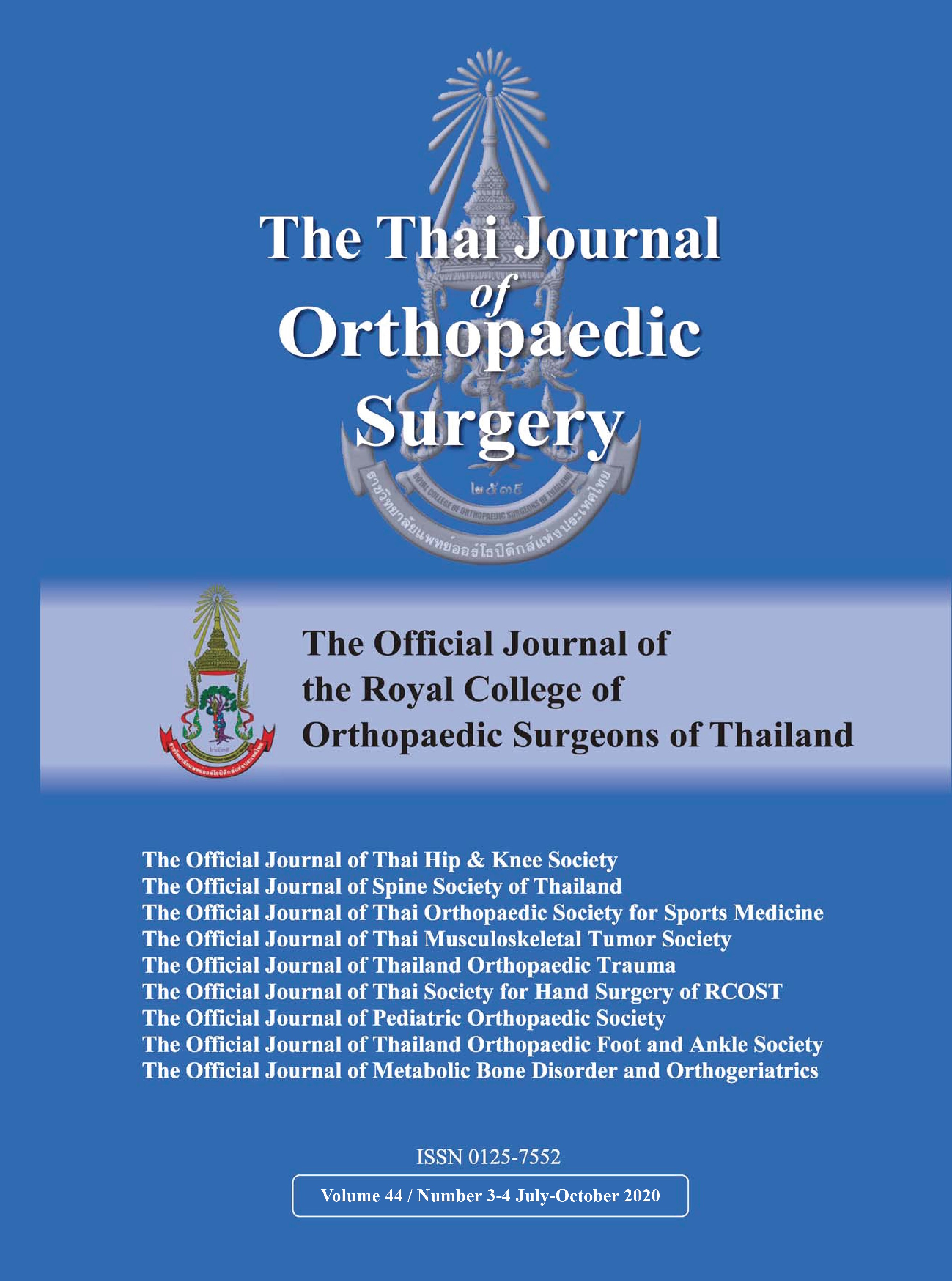Biportal Endoscopic Spine Surgery for Single Lumbar Disc Herniation or Lumbar Stenosis: Comparison between right and left side approach of right-handed surgeon
Main Article Content
Abstract
Purpose: Aim of the study was to compare the outcomes of the surgical treatment between right sided biportal endoscopic spine surgery (R-BESS) and the left sided biportal endoscopic spine surgery (L-BESS) approach for single-level lumbar disc herniation (LDH) or lumbar spinal stenosis (LSS) of right-handed surgeon.
Methods: Retrospective cohort study was conducted in adult patients with single LDH or LSS who underwent biportal endoscopic lumbar discectomy or lumbar stenosis decompression by right-handed spine surgeon between December 2018 and May 2020. The surgical side approaches were chosen according to symptomatic side and the finding from magnetic resonance imaging. Perioperative and post-operative outcomes were evaluated comparison between L-BESS and R-BESS.
Results: A total of 51 cases were enrolled, of which female to male ratio was 30:21 Mean age was 40.2±10.8 years. Thirty-one cases underwent L-BESS with the ratio for L-BESS and R-BESS was 1.5:1. L4/5 level was the most common surgical level in both L-BESS and R-BESS approach. The mean operative time (OT), mean estimated blood loss, Oswestry Disability Index (ODI) before and after surgery, back pain evaluated by visual analogue score (VAS) before and after surgery, MacNab criteria for patient satisfactory outcomes, hospital stay, hospital costs and immediate postoperative complication were not significant difference between L-BESS and R-BESS with p=0.77, 0.22, 0.52, 0.08, 0.18, 0.67, 0.82, 0.59, 0.27, and 0.30, respectively.
Conclusions: BESS for single LDH or LSS had comparable perioperative and postoperative outcomes between right and left sided approach.
Article Details
References
2. Choi K-C, Shim H-K, Hwang J-S, Shin SH, Lee DC, Jung HH, et al. Comparison of Surgical Invasiveness Between Microdiscectomy and 3 Different Endoscopic Discectomy Techniques for Lumbar Disc Herniation. World Neurosurg. 2018; 116: e750-8.
3. Torudom Y, Dilokhuttakarn T. Two Portal Percutaneous Endoscopic Decompression for Lumbar Spinal Stenosis: Preliminary Study. Asian Spine J. 2016; 10(2): 335-42.
4. Torudom Y, Jundamrongkul J. Biportal Percutaneous Endoscopic Discectomy for Recurrent Lumbar Disc Herniation: Preliminary Report. J Med Assoc Thai. 2017; 100(10): 179.
5. Park S-M, Kim G-U, Kim H-J, Choi JH, Chang B-S, Lee C-K, et al. Is the Use of a Unilateral Biportal Endoscopic Approach Associated with Rapid Recovery After Lumbar Decompressive Laminectomy? A Preliminary Analysis of a Prospective Randomized Controlled Trial. World Neurosurg. 2019; 128: e709-18.
6. Choi CM, Chung JT, Lee SJ, Choi DJ. How I do it? Biportal endoscopic spinal surgery (BESS) for treatment of lumbar spinal stenosis. Acta Neurochir (Wien). 2016; 158(3): 459-63.
7. Lin G-X, Huang P, Kotheeranurak V, Park C-W, Heo D-H, Park C-K, et al. A Systematic Review of Unilateral Biportal Endoscopic Spinal Surgery: Preliminary Clinical Results and Complications. World Neurosurg. 2019; 125: 425-32.
8. Choi D-J, Choi C-M, Jung J-T, Lee S-J, Kim Y-S. Learning Curve Associated with Complications in Biportal Endoscopic Spinal Surgery: Challenges and Strategies. Asian Spine J. 2016; 10(4): 624-9.


